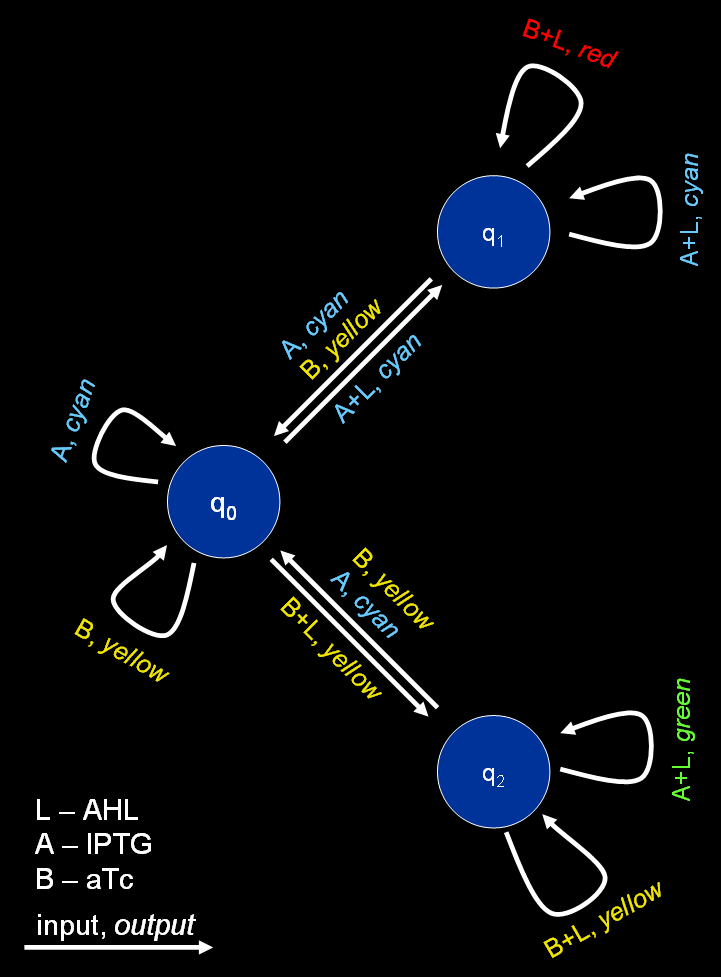ETHZ/Intro Tim
From 2007.igem.org
(Difference between revisions)
(→'''.:: System Explanation ::.''') |
(→'''.:: System Explanation ::.''') |
||
| Line 2: | Line 2: | ||
[[Image:FSM.png|thumb|450px|Figure 1: Graph representing the finite state machine.]] | [[Image:FSM.png|thumb|450px|Figure 1: Graph representing the finite state machine.]] | ||
The proposed system is best described by a [http://en.wikipedia.org/wiki/Mealy_machine Mealy machine], a special type of [http://en.wikipedia.org/wiki/Finite_state_machine finite state machines] (FSM). Mealy machines are defined by a 6-tuple, (''Q'', ''q''<sub>0</sub>, Σ, Λ, ''δ'', ''Ω''), with: | The proposed system is best described by a [http://en.wikipedia.org/wiki/Mealy_machine Mealy machine], a special type of [http://en.wikipedia.org/wiki/Finite_state_machine finite state machines] (FSM). Mealy machines are defined by a 6-tuple, (''Q'', ''q''<sub>0</sub>, Σ, Λ, ''δ'', ''Ω''), with: | ||
| - | * ''Q'' - a set of states, for the proposed system we use | + | * ''Q'' - a set of states, for the proposed system we use three different states (''q''<sub>0</sub> - not yet trained, ''q''<sub>1</sub> - trained to recognize chemical A, ''q''<sub>2</sub> - trained to recognize chemical B) |
* ''q''<sub>0</sub> - a start state, here we assume we start in a state where the system is not yet trained | * ''q''<sub>0</sub> - a start state, here we assume we start in a state where the system is not yet trained | ||
| - | * Σ = { | + | * Σ = {A+L, A, B+L, B} - an input alphabet |
| - | * Λ = {green, red, | + | * Λ = {''green'', ''red'', ''blue'', ''yellow''} - an output alphabet |
* ''δ'' : ''Q'' × Σ → ''Q'' - a state transition function | * ''δ'' : ''Q'' × Σ → ''Q'' - a state transition function | ||
* ''Ω'' : ''Q'' × Σ → Λ - an output function | * ''Ω'' : ''Q'' × Σ → Λ - an output function | ||
| Line 15: | Line 15: | ||
! inputs/states !! ''q''<sub>0</sub> !! ''q''<sub>1</sub> !! ''q''<sub>2</sub> | ! inputs/states !! ''q''<sub>0</sub> !! ''q''<sub>1</sub> !! ''q''<sub>2</sub> | ||
|- | |- | ||
| - | ! | + | ! A+L || ''q''<sub>1</sub> || ''q''<sub>1</sub> || ''q''<sub>1</sub> || |
| - | ! | + | ! A+L || ''green'' || ''green'' || ''blue'' |
|- | |- | ||
| - | ! A || ''q''<sub>0</sub> || ''q''<sub> | + | ! A || ''q''<sub>0</sub> || ''q''<sub>0</sub> || ''q''<sub>0</sub> || |
| - | ! A || | + | ! A || ''green'' || ''green'' || ''green'' |
|- | |- | ||
| - | ! | + | ! B+L || ''q''<sub>2</sub> || ''q''<sub>2</sub> || ''q''<sub>2</sub> || |
| - | ! | + | ! B+L || ''yellow'' || ''red'' || ''yellow'' |
|- | |- | ||
| - | ! B || ''q''<sub>0</sub> || ''q''<sub> | + | ! B || ''q''<sub>0</sub> || ''q''<sub>0</sub> || ''q''<sub>0</sub> || |
| - | ! B || | + | ! B || ''yellow'' || ''yellow'' || ''yellow'' |
|- | |- | ||
|} | |} | ||
| - | |||
| - | |||
The resulting automaton is represented by Fig. 1. | The resulting automaton is represented by Fig. 1. | ||
Revision as of 09:30, 18 October 2007
.:: System Explanation ::.
The proposed system is best described by a [http://en.wikipedia.org/wiki/Mealy_machine Mealy machine], a special type of [http://en.wikipedia.org/wiki/Finite_state_machine finite state machines] (FSM). Mealy machines are defined by a 6-tuple, (Q, q0, Σ, Λ, δ, Ω), with:
- Q - a set of states, for the proposed system we use three different states (q0 - not yet trained, q1 - trained to recognize chemical A, q2 - trained to recognize chemical B)
- q0 - a start state, here we assume we start in a state where the system is not yet trained
- Σ = {A+L, A, B+L, B} - an input alphabet
- Λ = {green, red, blue, yellow} - an output alphabet
- δ : Q × Σ → Q - a state transition function
- Ω : Q × Σ → Λ - an output function
In detail, the transition function δ and the output function Ω look as follows:
| inputs/states | q0 | q1 | q2 | inputs/states | q0 | q1 | q2 | |
|---|---|---|---|---|---|---|---|---|
| A+L | q1 | q1 | q1 | A+L | green | green | blue | |
| A | q0 | q0 | q0 | A | green | green | green | |
| B+L | q2 | q2 | q2 | B+L | yellow | red | yellow | |
| B | q0 | q0 | q0 | B | yellow | yellow | yellow |
The resulting automaton is represented by Fig. 1.
